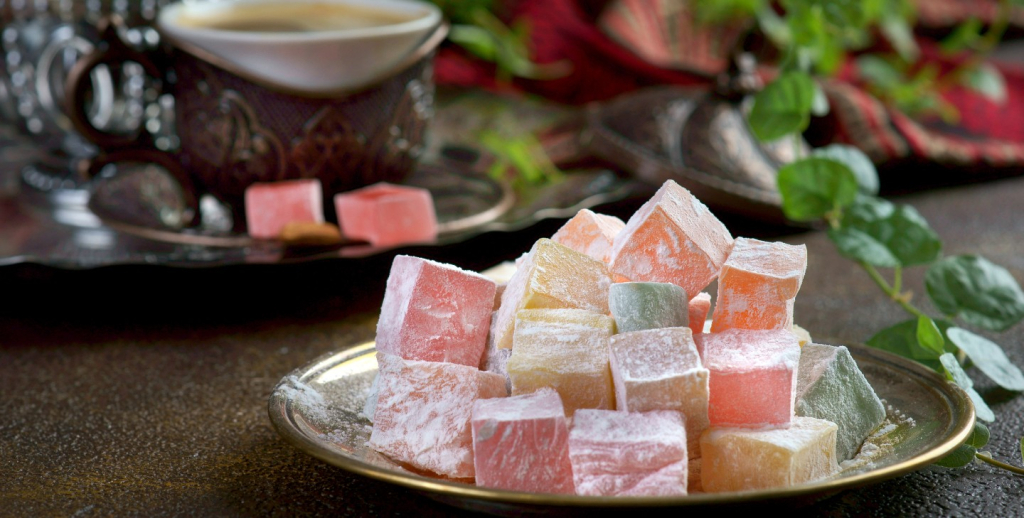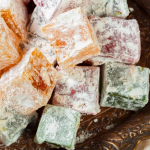Turkish delight continues to appeal to both the palate and the heart as one of the indispensable desserts of Turkish cuisine for centuries. It is not only a dessert, but also a symbol of hospitality, elegant treats and cultural heritage. Many aspects of Turkish delight, from what it is to its history, from its varieties to the best accompaniments with Turkish delight, are included in the rest of our article.
What is Turkish Delight?
Lokum; It is a Turkish dessert prepared on the basis of sugar, water and starch, soft in consistency, pleasant to chew, and disintegrating in the mouth. This flavour, which has survived from the Ottoman period to the present day, has been enriched with many flavours such as pistachio, walnut, rose, lemon and mastic gum.
History of Turkish Delight
Although the origin of Turkish delight dates back to the 15th century, it was popularised in the 18th century. Lokum, which was frequently served in the palace kitchen during the reign of Abdülhamid II, attracted the attention of European travellers and became known worldwide under the name ‘Turkish Delight’. Turkish delight also plays an important role in Turkey’s cultural promotion.
How Does Turkish Delight Taste?
Although the taste of Turkish delight varies according to the ingredients and flavours used in its production, it is generally slightly sweet, aromatic and refreshing. Although it is sugary, it is not suffocating. When cooked in the right proportions, it has a soft, non-stick and easily chewable consistency.
Types of Turkish Delight
Turkish delight has flavours and ingredients that differ according to regions. Here are some of the most known Turkish delight varieties:
- Turkish Delight with Roses: It stands out with its light aroma and pinkish colour.
- Turkish Delight with Pistachio: It is a satisfying type with plenty of pistachios.
- Turkish Delight with Walnut: It is preferred with its dense consistency and harmony with walnut.
- Plain Turkish Delight: Traditional, unadulterated, soft textured.
- Gumdrop Turkish Delight: It is especially common in the Aegean Region.
- Cocoa Turkish Delight: It is a specially produced variety for chocolate lovers.
In Which Region is Turkish Delight Produced Mostly?
Although Turkish delight is produced in many regions of Turkey, Afyonkarahisar, Istanbul, Safranbolu and Osmaniye are especially famous for their Turkish delight. Afyon Turkish delight stands out with its soft texture and quality pistachios. Safranbolu Turkish delight has gained fame by receiving a geographical sign.
What goes well with Turkish Delight?
Turkish delight is usually served with Turkish coffee. Especially pistachio or rose Turkish delight served with black Turkish coffee creates a nice balance with the bitterness of coffee. It can also be served with tea, fruit juice or sherbet on special occasions. The fact that it is frequently served at festivals and weddings makes lokum a ‘celebration dessert’.

A Delicious Souvenir from Turkey: Turkish Delight
Every trip to Turkey is an experience full of colourful marketplaces, historical textures, warm hospitality and of course unforgettable tastes. One of the sweetest traces of this journey is undoubtedly lokum, which has been around for centuries.
Turkish delight is a culture packed in elegant boxes, a flavour that delights the palate and a memory that stays in the heart. While it appeals to every palate with its rose, pistachio, walnut or gumdrop varieties, its harmony with Turkish coffee makes it almost a tradition.
A few boxes of Turkish delight that you will throw in your bag on your way back home will not only be a dessert but also the best souvenir of a journey. This small gift you will take to your loved ones is a meaningful symbol reflecting the warmth, elegance and flavour culture of Turkey. Because each grain of Turkish delight carries the traces of the past, the elegance of today and the sweetness of friendships.
This traditional flavour, which dates back to the Ottoman Empire, also reflects the cultural richness of Turkey. Whether as a treat or as a gift, Turkish delight always leaves a pleasant taste in the mouth and a beautiful memory in the heart.
A sweet heritage is kept alive for generations. Turkish delight is the most delicious part of this heritage.










